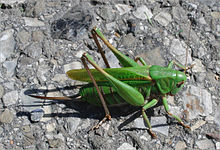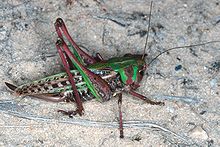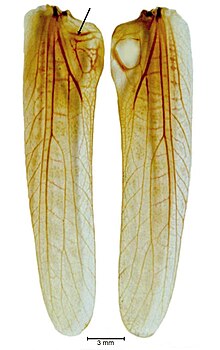Wartbite
| Wartbite | ||||||||||||
|---|---|---|---|---|---|---|---|---|---|---|---|---|

Wart-biter ( Decticus verrucivorus ), ♂ |
||||||||||||
| Systematics | ||||||||||||
|
||||||||||||
| Scientific name | ||||||||||||
| Decticus verrucivorus | ||||||||||||
| ( Linnaeus , 1758) |
The wart-biter ( Decticus verrucivorus ) is a long- feeler insect from the superfamily of the grasshopper (Tettigonioidea). It has a rather strange name for locusts. Because of its caustic digestive juices, the animal was previously allowed to bite its warts and hoped that this would have a healing effect.
features
The males are 24 to 38 millimeters long, the females 26 to 44 millimeters long. The color varies between green, yellow-brown and black-brown, and the animals are often piebald from a mixture of these colors. The wings have dark brown cube marks. They are narrow and small compared to the massive body. In the males, the forewings are on average 27.36 mm long, the length of the hind wings, which are completely covered by the forewings at rest, is on average 24.70 mm. In females, the forewings measure on average 29.03 mm, the hind wings 26.65 mm. Very short-winged forms (from Italy) and long-winged specimens (see fig.) Are known. The antennae are about body length. The long laying tube ( ovipositor ) of the females is slightly curved upwards. The cerci of the males have teeth behind the middle.
Occurrence
The wart-biter is common in Europe and Asia . In the north, the distribution extends to the south of England and Scandinavia . The animals live mainly on low-growing mountain meadows, on dry grass and also on wet meadows . They are also often found on fallow fields . They feed mainly on insects, but also on plants.
Way of life
Wart biters are diurnal. When mating, the male clings to the female's laying tube with its front legs. The light-colored eggs are laid individually in the earth. It takes about one and a half years for the larvae to grow. The first adult animals can be observed in Central Europe from the beginning of June. In the south of Europe the adults appear earlier, in the north later.
Singing and sound organ
The sexually mature males only sing in the sunshine. They have a species-specific chant that consists of long sequences of short zig-sounds separated by intervals. If the singing is sustained, the intervals shorten, but the individual sounds can still be heard even if they are repeated quickly.
The sound organ is located at the base of the forewings and stands out from the rest of the wing by its brown color. All structures are present on both wings, but in different forms according to their functions (picture). On the left wing, the shrill charger with the shrill ledge is well developed. It is on average 2.85 mm long and has an average of 73 to 75 oval-shaped shrill teeth on the underside. When singing, the shrill teeth of the left wing brush the shrill edge of the right wing. On the right wing, however, the shrill ledge is weak. It measures an average of only 1.55 mm and has only 42.80 shrill teeth that are not involved in the generation of sound. In contrast, the right wing is equipped with a well-designed mirror that acts as a resonator. It consists of a very thin, completely transparent membrane, which is clamped in a stable frame. On the left wing, the mirror has almost completely receded.
The development of the shrill teeth was compared with the wart-bite and the Mediterranean field cricket (see there). The course of development is the same for both. In the wartbiter, in the course of the last larval stage , lamellar cells and intermediate cells arranged in a row above the posterior cubital vein of the forewing appear , which alternate with one another and are covered with chitin. The nuclei of both cell types are very large, which suggests high cell activity. The lamellas or shrill teeth are created by the fact that the lamellar cells grow beyond the surface of the new wing, while the intermediate cells simultaneously retreat inward. Shortly after the imaginal molt, the wing expands to full size and the shrill teeth assume their final position. The lamellar cells then separate from the chitin, soon afterwards also the intermediate cells, and as a result both cell types degenerate rapidly.
Hazard and protection
The species is sensitive to environmental changes and has already disappeared in parts of Germany.
- Red list FRG: 3 (endangered).
Historical
August Johann Rösel von Rosenhof described the species in his famous work "Insect amusements". He drew several color variations and development stages of the species in a very natural way (see illustration). Here is an excerpt from the original description of the wart-biter from page 57f. of the 2nd volume of the "Insect amusement" from 1749:
Ҥ 10. Since these animals are very vicious; so you have to be careful if you want to catch them: then where they find the bare skin they tend to bite so sharply that the blood immediately follows it. At the same time, a brown juice flows from her mouth, which is nothing other than the food transformed into a liquid matter in the front throat. But that their till happens with considerable force, it is evident from the fact that they are allowed to bite into the hat and at the same time they are pulled away, the head with the throat remains hanging on the hat at all times and is torn from the rest of the body.
Otherwise the locusts like to go out, and just as they can hop quickly and far with the help of their jumping feet; so their wings also serve them to move through the air from one place to another. Their enemies are different birds, which like to chase after them because they serve so well for their food as well as their young. They have an internal enemy in the so-called twisted worm: this is sometimes found in them for a quarter of a cubit, but is therefore only the thickness of a twisted thread and wears them out so that they can be removed many times before the time otherwise determined for them to end their lives. Instead of this worm, one often finds them, especially not long before their due death, filled with maggots, which mosquitoes have their origin from. "
Individual references and references
- ↑ a b c d Anna Alfonsa Stark: Investigations on the sound organ of some crickets and grasshopper species, at the same time a contribution to the right-left problem. Zoological yearbooks, anatomy department 77, pp. 9–50, 1958.
- ↑ Peter Detzel: The locusts of Baden-Württemberg. Verlag Eugen Ulmer GmbH & Co, Stuttgart 1998, ISBN 3-8001-3507-8
- ↑ Jörn Vorwald: Extremely early appearance of adult Decticus verrucivorus (Linnaeus 1758) . Articulata Vol. 13 (2) 1998 pp. 139-147
- ↑ Federal Agency for Nature Conservation (Ed.): Red List of Endangered Animals in Germany. Landwirtschaftsverlag, Münster 1998, ISBN 978-3-89624-110-8
literature
- Heiko Bellmann : Der Kosmos Heuschreckenführer, The species of Central Europe safely determine , Franckh-Kosmos Verlag GmbH & Co KG, Stuttgart 2006, ISBN 3-440-10447-8 .
- Anna Alfonsa Stark: Investigations on the sound organ of some crickets and grasshopper species, at the same time a contribution to the right-left problem. Zoological yearbooks, anatomy department 77, pp. 9–50, 1958.
- August Johann Rösel von Rosenhof : Insect amusement, part 2. Verlag JJ Fleischmann, Nuremberg 1749



